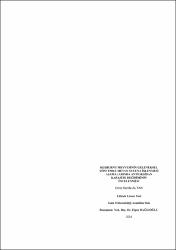| dc.contributor.author | Altan, Deniz Damla | |
| dc.date.accessioned | 2017-05-02T12:49:14Z | |
| dc.date.available | 2017-05-02T12:49:14Z | |
| dc.date.issued | 2014 | |
| dc.identifier.uri | https://hdl.handle.net/20.500.11776/600 | |
| dc.description.abstract | Kuşburnu son yıllarda önemi anlaşılan, ülkemizde yabani olarak yetişmekte olan, besleyici değeri yüksek bir meyvedir. Kuşburnu fenolik maddeler ve askorbik asit gibi antioksidanlarca zengindir. Kuşburnu çay, marmelat ve nektar olarak işlenip tüketilmektedir. Antioksidanlarca zengin olan kuşburnunun ürünlere işlenmesi sırasında doğal antioksidan bileşikler ve antioksidan aktivitede değişim olduğu bilinmektedir. Bu çalışma son yıllarda kullanımı artmakta olan kuşburnu meyvesinin geleneksel olarak meyve suyuna işlenmesi sırasında antioksian kapasitesindeki değişimi incelemeyi amaçlamıştır. Analizde kullanılan kuşburnu Kırklareli yöresinde kırsal bölgelerden toplanarak -20 ºC’ de depolanmıştır. Üretim sırasında dondurulan meyve oda koşullarında çözündürüldükten sonra hammadde, ön ısıl işlem, pulp ve meyve suyu olmak üzere 4 farklı aşamadan örnekler alınarak bazı fiziksel, kimyasal ve antioksidan aktivite özellikleri incelenmiştir. Yapılan analiz sonuçlarında, kuşburnu hammaddesinde ve meyve suyunda kuru madde sırasıyla %39-7,58 arasında; suda çözünür toplam kuru madde miktarı %22.86-8.6 arasında; pH 3.78-3.72 arasında; titrasyon asitliği %1.94-0.61(malik asit) arasında; kül %2.8214-1.2107 arasında; formol sayısı 10-5,5 arasında; toplam şeker %13.12-5.90 arasında; invert şeker %9.58-3.82 arasında; sakaroz 3.36- 1.97 g/100g arasında; HMF 1.26-28.45 mg/L arasında; renk ölçümü L, a, b değerleri sırasıyla 24,96-26,52; 26,27-18,07; 10,59-15,04 arasında belirlenmiştir. Üretim sırasında pH ve L değeri dışındaki tüm özelliklerde değişimler istatistiksel açıdan önemli (p< 0.05) bulunmuştur. Çalışmada askorbik asit 763.98-112.4 mg/g, toplam fenolik madde ( etanol ekstratında) 6147.5-15290 mg/kg olarak belirlenmiştir. Kuşburnu örneklerinin antioksidan kapasitesi TEAC değerleri hammadde, ön ısıl işlem, pulp ve meyve suyu aşamalarında sırasıyla; 696,71 µM troloks /g, 682,57 µM troloks/g, 346,02 µM roloks/g, 28,24 µM troloks /g olarak tespit edilmiştir. Analizler sonucu askorbik asit, fenolik madde ve antioksidan özelliklerin değişimi istatistiksel olarak önemli bulunmuştur (p<0,05). | en_US |
| dc.description.abstract | Rosehip is a fruit, whose importance has been understood recently, that grows wildly in our country and has sustenance. It is rich in phenolic substances and antioxidants such as ascorbic acid. Rosehip consumed as tea, marmalade and nectar after it is processed. During the transformation of rosehip, which is rich in antioxidants, into products, it is being thought that there will be changes in the natural antioxidant compounds and antioxidant activity. The aim of this study is to examine the antioxidant capacity changes that occur during the transformation of rosehip fruit, whose usage is on the rise in the recent years, into fruit juice traditionally. The rosehip that was used in the study was collected from rural zones of Kırklareli region and stored at -20 0C. During the production process, some of its chemical, physical, and antioxidant features were examined by taking some samples from the stages such as staple, pre-thermal process, pulp and fruit juice, after the frozen fruit was solubilized in the room temperature. In the results of the analysis, dry substance in the rosehip stable and fruit juice has been determined respectively between 39-7.58% ; water soluble dry substance is between 22.86-8.6% ; pH is between 3.78-3.72% ; titratable acidity ( as malic acid ) is between 1.94- 0.61% (malic acid); ash is between 2.8214-1.2107%; formol number is between 10-5,5; total sugar is between 13.12-5.90%; invert sugar is between 9.58-3.82%; saccharose is between 3.36-1.97 g/100g; HMF is between 1.26-28.45 mg/L; colorimetry L, a, b values are respectively between 24.96-26.52; 26.27-18.07; 10.59-15.04 respectively. The changes in L values and pH during the production were not found statistically significant in terms of statistics significant (p>0.05). Other results of analysis of the changes in the features during the production are found statistically significant in terms of statistics (p< 0.05). It is found out in the study that ascorbic acid is 763.98-112.4 mg/g and total phenolic content (in the ethanol extract) is 6147.5-15290 mg/kg. Antioxidant capacity in the rosehip stable and fruit juice has been determined as 696,71 µM troloks /g, 682,57 µM troloks/g, 346,02 µM roloks/g, 28,24 µM troloks /g respectively. The changes in ascorbic acid , total phenolic substance and antioxidant capacity of the changes in the features during the production are found statistically significant in terms of statistics (p< 0.05). | en_US |
| dc.language.iso | tur | en_US |
| dc.publisher | Namık Kemal Üniversitesi | en_US |
| dc.rights | info:eu-repo/semantics/openAccess | en_US |
| dc.subject | Kuşburnu | en_US |
| dc.subject | Kuşburnu Meyve Suyu | en_US |
| dc.subject | Toplam Fenolik Madde | en_US |
| dc.subject | Antioksidan Aktivite | en_US |
| dc.subject | Askorbik Asit | en_US |
| dc.subject | Rosehip | en_US |
| dc.subject | Rosehip fruit juice | en_US |
| dc.subject | Total phenolic compounts | en_US |
| dc.subject | Ascorbic acid | en_US |
| dc.subject | Antioxidant capacity | en_US |
| dc.title | Kuşburnu meyvesinin geleneksel yöntemle meyve suyuna işlenmesi aşamalarında antioksidan kapasite değişiminin incelenmesi | en_US |
| dc.title.alternative | Investi̇gati̇on of anti̇oxi̇dant capaci̇ty changes of rosehi̇p frui̇ts i̇nto frui̇t jui̇ce processi̇ng stages tradi̇ti̇onally | en_US |
| dc.type | masterThesis | en_US |
| dc.department | Enstitüler, Fen Bilimleri Enstitüsü, Gıda Mühendisliği Ana Bilim Dalı | en_US |
| dc.relation.publicationcategory | Tez | en_US |



















